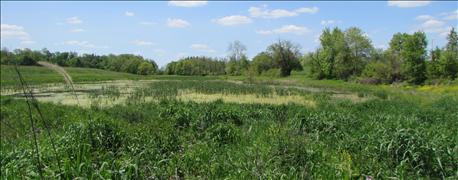
Farmers often invest the same dollars in inputs on each acre, whether it produces a good crop every year or not. Here’s an example where a farmer grew tired of investing those inputs, plus time and labor, only to receive meager returns in most years — and sometimes not enough to cover costs.
Tandy Easler helped advise this landowner in DeKalb County, and was involved in designing a wetland to permanently resolve flooding issues in the field. Easler is a Natural Resources Conservation Service civil engineering technician for the Albion Conservation Delivery Team within NRCS.

CONVERTED: NRCS staff helped the landowner convert this acreage from wet, hard-to-manage farmland to a wetland that works to resolve flooding issues in the field. (Photo courtesy of Kris Vance, Natural Resources Conservation Service)
Before the landowner sought help, he fought flooding and wetness problems for years in this part of the field, Easler reports. It was a relatively small area in terms of acres, but a big headache when it came to farming the field.
After the landowner contacted NRCS and staff explained the value of converting the acreage to a wetland, he agreed. He enrolled the area in what was then the NRCS Wetland Reserve Program. Today the same program is called the Agricultural Conservation Easement Program. It provides financial incentives to make the conversion.
Wetland solution
The purpose of creating this wetland was to return the area to approximately what it would have been like before the land was cleared for farming, Easler says. “The purpose of wetland restoration [in general] is to return the wetland’s value, habitat, diversity and capacity to a close approximation of its original condition that existed prior to disturbance,” she explains.
This particular restoration project included 3.5 acres of shallow water restoration, Easler notes. The landowner planted another 1.4 acres to trees and shrubs, including white pine, hazelnut, Washington hawthorn and button bush.
The entire project took about two years, Easler relates. As part of the plan, the landowner also planted a number of plants, many of which provide habitat for various types of wildlife. The prairie and sedge meadow planting covers 9.5 acres around the wetland.
Species planted in the meadow include Canada wild rye, indiangrass, little bluestem, Virginia wild rye and big bluestem. In addition to these warm-season grasses, the farmer planted 25 species of forbs and legumes.

BEFORE: This area was prone to flooding, often remained wet and was difficult to farm nearly every year.

AFTER: Here is the same area after NRCS staff advised the landowner how to convert it into a wetland to help resolve flooding issues in the field. (Photos courtesy of Kris Vance, Natural Resources Conservation Service)
About the Author(s)
You May Also Like




